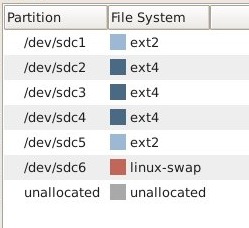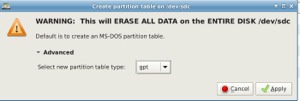In How to Upgrade Your Linux PC Hardware we learned about choosing Linux-compatible components, and some great Linux commands for probing hardware without opening the box. Today we’re going to explore the mysteries of GPT, the GUID partition table, which is the newfangled replacement for the tired and inadequate MS-DOS partition table, and why you might want to use it instead of the familiar old MBR. GPT is part of the UEFI specification, and because Linux is a real operating system with modern features you can use GPT with both UEFI and legacy BIOS.
Retiring the MBR
The Globally Unique Identifiers Partition Table is the modern replacement for the antique MS-DOS Master Boot Record (MBR). The MBR was born in the early 1980s for IBM PCs, way back in the thrilling days of ten-megabyte hard disks. The MBR must live on the first 512 bytes of your storage device, and it holds the bootloader and partition table. The bootloader occupies 446 bytes, the partition table uses 64 bytes, and the remaining two bytes store the boot signature. The MBR is limited to four primary partitions, and a single primary partition can hold an extended partition which can then be divided into logical partitions. Linux supports (theoretically) an unlimited number of logical partitions. In the olden days Linux maxed out at 63 IDE partitions and 15 SCSI partitions because the kernel was limited in the total device numbers it could allocate. udev allocates device numbers dynamically, so those limitations are gone.

The MBR is tiny and inflexible, and has lasted this long thanks to clever hacks to get around its limitations. Logical Block Addressing (LBA) gets around the limitations of its original cylinders, heads, and sectors (CHS) addressing. The traditional hard disk block size of 512 bytes limits partitions to 2TB in size, though more clever hackery supports the new 4096-byte sectors for a maximum 16TB partition size.
GUID Partition Table (GPT)
Clever hackery takes us far, and modern tools take us even farther. GPT is part of the Unified Extensible Firmware Interface (UEFI) specification, and on Linux you don’t need an EFI BIOS to boot from a GPT partition, but can use it with legacy BIOS systems. Mac OS X and Windows have various limitations that make me tired to even think about, so if these are an issue for you this Microsoft FAQ and Apple’s Secrets of the GPT should help you.
GPT does not have primary and logical partitions, but just partitions as GParted shows (figure 1).
When you’re formatting a hard disk in GParted and want to use GPT, just select the gpt option, as in figure 2:
 GPT has several advantages over the MBR:
GPT has several advantages over the MBR:
- 64-bit disk pointers allows 264 total sectors, so a hard disk with 512-byte blocks can be as large as 8 zebibytes. With 4096-byte sectors your maximum disk size is really really large
- The default maximum number of partitions is 128, and if your operating system supports it you can have more
- No more CHS cruft or hacky primary-extended-logical partitioning scheme, which falls down if you need Windows because Windows is inflexible and hogs primary partitions
- GPT has fault-tolerance by keeping copies of the partition table in the first and last sector on the disk
- GPT computes a cyclic redundancy check (CRC) checksum to verify its own integrity, and of the partition table
- Unique IDs for disks and partitions.
Unique IDs
The GPT GUIDs (Globally unique identifiers) and our familiar Linux UUIDs (Universally Unique Identifiers) are not the same thing, though they serve the same useful purpose: giving block devices unique names. Linux UUIDs are a function of filesystems, and are created when the filesystem is created. To see Linux UUIDs just fire up the blkid command:
# blkid /dev/sda1: LABEL="storage" UUID="60e97193-e9b2-495f-8db1 -651f3a87d455" TYPE="ext4" /dev/sda2: LABEL="oldhome" UUID="e6494a9b-5fb6-4c35-ad4c- 86e223040a70" TYPE="ext4"
This example also shows the filesystem labels, which are arbitrary names we can give our block devices. We can use the UUIDs in /etc/fstab like this:
# storage, /dev/sda1 data storage UUID=60e97193-e9b2-495f-8db1-651f3a87d455 /home/carla/storage ext4 user,defaults 0 0
Or use the label, like this:
LABEL=storage /home/carla/storage ext4 user,defaults 0
To get GUIDs we need the gdisk command:
# gdisk /dev/sdc GPT fdisk (gdisk) version 0.8.1 Partition table scan: MBR: protective BSD: not present APM: not present GPT: present Found valid GPT with protective MBR; using GPT. Command (? for help):
This offers immediately useful information: That this disk uses GPT, with an MBR in protective mode. This protected MBR allows booting from a legacy BIOS, and and protects GPT from GPT-unaware utilities (such as fdisk) and operating systems. These will see an MBR disk with no free space. gdisk serves up a wealth of information on partitions. Press the p key to see all partitions:
Command (? for help): p Disk /dev/sdc: 3907029168 sectors, 1.8 TiB Logical sector size: 512 bytes Disk identifier (GUID): 058D39EE-5D06-409F-AA0C-298A3E6CC302 Partition table holds up to 128 entries First usable sector is 34, last usable sector is 3907029134 Partitions will be aligned on 2048-sector boundaries Total free space is 819142765 sectors (390.6 GiB) Number Start (sector) End (sector) Size Code Name 1 2048 1953791 953.0 MiB 0700 2 1953792 80078847 37.3 GiB 0700 3 80078848 2033203199 931.3 GiB 0700 4 2033203200 3009765375 465.7 GiB 0700 5 3009765376 3048826879 18.6 GiB 0700 6 3048826880 3087888383 18.6 GiB 8200
Note that the logical sector size is 512 bytes. All new large hard disks use 4096-byte sectors, so what’s up? Let’s fire up the lsblk command and see:
$ lsblk -t /dev/sdc NAME ALIGNMENT MIN-IO OPT-IO PHY-SEC LOG-SEC ROTA SCHED RQ-SIZE sdc 0 4096 0 4096 512 1 cfq 128 |--sdc1 0 4096 0 4096 512 1 cfq 128 |--sdc2 0 4096 0 4096 512 1 cfq 128 |--sdc3 0 4096 0 4096 512 1 cfq 128
This shows that the physical sectors are 4096 bytes. 4096 bytes is a magic number on large hard drives for multiple reasons: it’s a more efficient use of storage space, a normal page of memory on x86 computers is 4096 bytes, and the ext3/4 file systems default to 4KB clusters. But to preserve backwards compatibility (disk controllers, older software and operating systems) hard disk manufacturers have to emulate 512B sectors.
Let’s go back to gdisk and examine a single partition. Press i, then the number of the partition:
Command (? for help): i Partition number (1-6): 3 Partition GUID code: EBD0A0A2-B9E5-4433-87C0-68B6B72699C7 (Microsoft basic data) Partition unique GUID: 8C208C30-4E8F-4096-ACF9-858959BABBAA First sector: 80078848 (at 38.2 GiB) Last sector: 2033203199 (at 969.5 GiB) Partition size: 1953124352 sectors (931.3 GiB) Attribute flags: 0000000000000000 Partition name: ''
Note the Partition GUID code, and how it says “Microsoft basic data.” Yeah, ole Microsoft always party-crashing, because this an EXT4 partition, so there is no way for Windows to read it, but will see it as an unformatted partition. You won’t see this with current releases of gdisk, because until 2011 there were no Linux filesystem GUIDs. Now there are, so if you’re not using an old Linux like mine (Mint 13) you’ll see a proper Linux GUID instead (0FC63DAF-8483-4772-8E79-3D69D8477DE4).
The Partition unique GUID is what you’ll use in fstab, like this:
PARTUUID=8C208C30-4E8F-4096-ACF9-858959BABBAA /data ext4 user,defaults 0 0
Linux GPT Support
As always, Linux has complete support for this newfangled stuff. You’ll need GRUB 2, though some users report that LILO works with GPT, gdisk, and GNU parted or GParted for a nice graphical view. Read the fine man pages, and Wikipedia’s GUID Partition Table nicely condenses a lot of useful information, including operating system support and a table of GUID labels.





